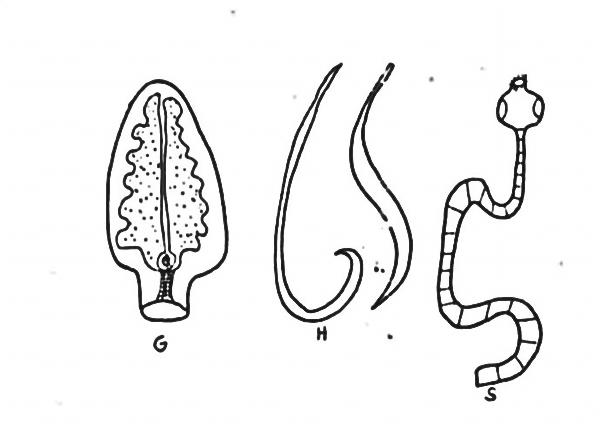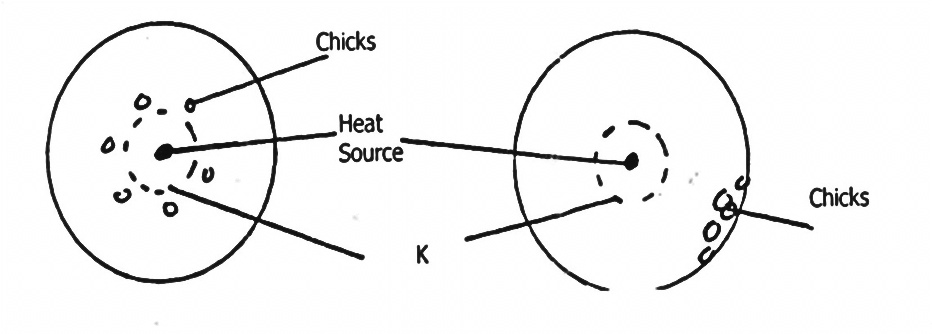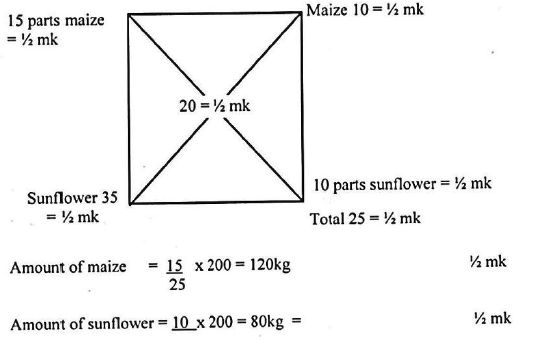443 / 2
AGRICULTURE
PAPER 2
MARKING SCHEME
MARCH 2018
CATHOLIC DIOCESE OF KERICHO (CDK) EXAMS – 2018
PRE-MOCK
AGRICULTURE PAPER 2
MARKING SCHEME
SECTION A (20 MARKS)
Answer all questions in this section in the spaces provided.
- Define the word breech of birth as used in livestock production (1mk)
Breech of birth is a presentation during parturition where the hind legs of a new born come out first. - Study the table below and fill in the missing words (3mks)
Description
Cattle
Pigs
Poultry
Young from birth/hatching to weaning
Calf piglet Chick
Young female before first parturition
Heifer Gilt
Pullet Mature male for breeding
Bull
boar cock - Outline the importance of feed additives (1mk)
- To stimulate growth and production
- To prevent disease attacks
- To improve feeding habits (appetite).
- List four implements used to carry out secondary cultivation (2mks)
- Disc harrow.
- Spike toothed harrow.
- Rotavator.
- Ox- tine harrow
- Chain harrow.
- Zigzag harrow.
- Sprung tine harrow.
- Give two reasons why walls of dairy shed should be white washed instead of painting with oil paints (1mk)
- Avoid poisoning by chemicals or lead that may be in paints.
- To discourage/avoid tainting of milk if shed is used immediately after painting
- Discourage insects from inhabiting the shed
- State two uses of wind power on the farm (2mks)
- Winnowing of crops
- Driving machines e.g. wind mill
- Name the two hormones that control milk left down in dairy cow (1mk)
- Oxytocin
- Adrenaline
- Name any two parts of marking gauge (2mks)
- Pin
- Head
- Stem
- Shoe
- Thumbscrew
- Give two uses of litter in a poultry house (2mks)
- Keeps birds busy scratching, hence reduce cannibalism
- Gives comfort and warmth to the birds
- Helps in drying droppings
- List four post milking practices (2mks)
- Disinfect the teats
- Apply milking salve on teats
- Weigh the milk
- Cooling the milk
- Straining/ sieving the milk
- Clean utensils
- Name two diseases that affect female animals only (1mk)
- Mastitis
- Milk fever
- State four factors that would contribute to depreciation of farm equipment (2mks)
- Growth, repair and replacement of worn-out body tissues.
- Production of antibodies which protect the animal from diseases.
- Production of digestive enzymes to break food particles.
- Production of certain hormones in the body.
- Production of such products like meat, milk, egg and wool.
- List four functions of proteins in livestock (2mks)
- Age of the equipment
- Wear and tear/use
- Lack of maintenance practice
- Exposure to weather/improper storage
- Obsolescence/change in technology
- State the measures that prevent egg eating in poultry (2mks)
- Collect eggs regularly and frequently.
- Make nests dark
- Feed balanced diet.
- Debeak perpetual egg eaters.
- Supply green leaves to keep birds busy.
- Name two livestock diseases controlled by the same vaccine and name the vaccine (1½mks)
- Anthrax & Black quarter/leg
- Vaccine - Blanthrax
- State three maintenance practices carried out on a milking machine (1½mks)
- Flushing the tubes under high pressure to it.
- Greasing / oiling rotating parts in the pump
- Storing it to dry upside down after thorough washing
- Apart from high butter fat which other good qualities is jersey breed having over other exotic dairy breeds (1mk)
- Hardy / withstand high temperatures
- Needs less food
- Excellent grazer on fairly poor pastures.
- State two functions of a coulter on a mould board plough (1mk)
- Makes a vertical cut into the soil ahead of the share to separate the furrow slice from unploughed land.
- Cut any trash on the surface
- Name two dual purpose breeds of cattle (1mk)
- Sahiwal
- Red poll
- Simmental
- Brown Swiss
SECTION B (20 MARKS)
Answer all questions in this section in the spaces provided
- The diagram labeled G, H and S below illustrated three livestock parasites. Study them and answer the questions that follow;

- Identify the parasites (1 ½ mks)
G-Liver fluke (Fasciola ssp) S-Tape worms (Taenia ssp)
H-Round worms (Ascaris ssp) - State the category to which the three parasites G,H and S belong to (1 ½ mk)
Internal/endoparasites. - Name the parts of organs of the host body where parasites G and S are found respectively (2mk)
G - Liver fluke is found in the bile duct gali bladder / liver. S-Tape worm are found attached on the wall of the small intestine. - State any three control measures of the parasite G (3 mks)
- Control of fresh water snail by physically killing them.
- Control of fresh water snail by use of adding CuSO4 solution to stagnant water.
- Draining swampy areas
- Burning swampy bushes during dry weather.
- Avoid grazing affected animals near marshy or swampy areas.
- Routine drenching with suitable. Anthelmintic.
- Rear ducks which feed on snails.
- Identify the parasites (1 ½ mks)
- Study the following diagram showing the behavior of chicks with temperature variations in a brooder

- Identify part K (1MK)
Wire guard - Describe the behavior of chicks in (2mks)
- X - Cold/low temperatures thus making chicks move closer to the heat source.
- W - Draught strong wind from one side which makes them to move to the opposite side.
- Identify part K (1MK)
- A farmer wanted to prepare a 200kg of calf rearing ration containing 20% DCP. Using the pearson’s square method, calculate the amount of maize containing 10% SCP and sunflower containing 35% DCP that the farmer would need to prepare the ration (show your working ) (4mks)

- Describe the characteristics of eggs selected for incubation (5mks)
- Be fertilized
- Medium size (50-60g) in weight
- Have smooth shells
- Oval in shape
- Free of any cracks in the shells
- Clean/pores open
- No abnormalities/blood spots/meat spots/double yolk
- Fresh/week old
SECTION C 40 MARKS
Answer any two questions in this section in the spaces provided after question 26
-
- State and explain five factors that influence the siting of farm structures (10mkS)
- Security : Located near homestead eg poulry house.
- Accessibility: should be connected with roads for easy of transportation of inputs/outputs
- Soil type - Should be well drained and unproductive
- Drainage / Gradient: When there is free flow of water
- Nearness to water sources eg. Vegetable nursery for easy irrigation
- Social amenities: Homesteads to be near schools, hospitals and churches
- Other infrastructure such as near roads and power lines
- View of farm (panoramic)
- Future expansion space to be left for future expansion
- outline five advantages of fences in a farm (5mks)
- They mark boundaries
- Keep off intruders / thieves
- Control grazing facilitate rotational grazing
- Prevent damage of crops by animals
- Control breeding
- Act as wind breaks
- Control of pests and diseases by preventing entry of wild and sick animals
- Live fences have aesthetic value
- Provide livestock feeds, firewood, mulch and compost manure material
- Add value to farms
- Outline five methods of reinforcing fences to make them stronger (5mks)
- Cementing the posts
- Inserting droppers between standard posts
- Supporting the corner posts with struts and strainers
- Tightening the wire strainers
- Fixing braces to support the fencing posts
- State and explain five factors that influence the siting of farm structures (10mkS)
-
- Describe the management practices that should be carried for a sow and piglets during the farrowing period (12mks)
- Clean and disinfect the far rowing pen
- Wash / clean and disinfectant the sow.
- Treat the sow against external parasites
- Move the sow to a furrowing pen - 3 days before furrowing
- Provide a creep area.
- Provide clean bedding maternal
- Provide bran for the sow after furrowing.
- Ensure piglest are breathing.
- Ensure piglets suckle colostrum
- Disinfect umbilical cord of piglets.
- Weigh piglets on day one to get birth weight
- Dispose the after - birth
- Dispose-off born still piglets on day 1 to attain birth weight.
- Explain reasons why a breeding boar may be culled (8mks)
- Old age Health of a boar Serious injury of the boar
- When daughters are used as replacement stock /to a oid inbreeding.
- When boar is too fat and lazy.
- Poor performance of offsprings
- Lack of libido / infertile boar.
- Bad temperament
- Describe the management practices that should be carried for a sow and piglets during the farrowing period (12mks)
-
- Describe maintenance practices which are carried out on farm buildings (10mks)
- Painting walls, wooden surfaces.
- Greasing hinges of doors.
- Oiling exposed metal part to avoid rusting e.g. steel posts.
- Regular cleaning.
- Repair of broken doors, windows, handles ecc.
- Using buildings for correct purpose.
- Avoiding banging objects into the building.
- Sealing of leaking roofs.
- Plastering, cementing walls to avoid vermins.
- Re-sealing / walling of cracked walls.
- Painting wooden parts of the roof with old engine oil to control insect attacks.
- Outline the factor considered when siting a bee hive. (5mks)
- Availability of water.
- Availability of flowers (food nector).
- Shelter / no overheating.
- Direction of wind.
- Noise sounds e.g. nearby posho mill.
- Smells e.g. damping site.
- Security away from living homes / livestock.
- Outline the management practices carried out in an incubator (5mks)
- Egg turning every 6 - 8 hours.
- Egg should be turned around 180°.
- Any egg found to be infertile should be removed on the 5th day.
- Broken eggs should be removed.
- Add water to maintain humidity.
- Maintain temperature within the set range.
- Describe maintenance practices which are carried out on farm buildings (10mks)
Download Agriculture Paper 2 Marking Scheme - CATHOLIC DIOCESE OF KERICHO (CDK) EXAMS – 2018 PRE-MOCK WITH MARKING SCHEME.
Tap Here to Download for 50/-
Get on WhatsApp for 50/-
Why download?
- ✔ To read offline at any time.
- ✔ To Print at your convenience
- ✔ Share Easily with Friends / Students

